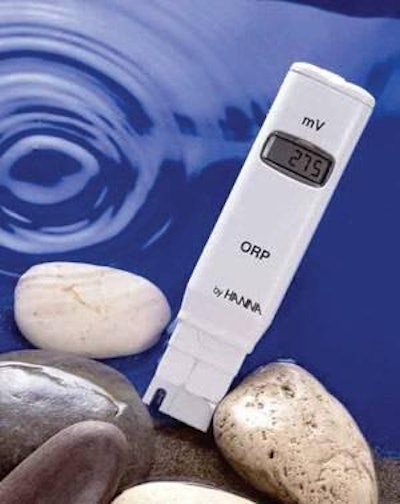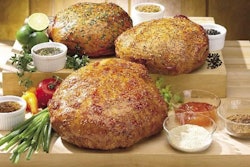
New proposals by USDA's Food Safety and Inspection Service (FSIS) in the Salmonella Initiative Program (SIP) and Public Health Risk-Based Inspection System (PHRBIS) spell trouble for poultry processors who don't keep salmonella in tighter check in the future. Processors stand to see line speeds slowed, food safety audit teams at their doors and their plants identified on the FSIS website, if salmonella levels don't consistently meet new, tighter limits. This means processors will be forced to focus their antimicrobial interventions in new and different ways. A more comprehensive and balanced approach to eliminating pathogenic bacteria will be required in order to meet the new requirements.
Many processors have come to rely upon one or two really well-run antimicrobial interventions to insure that salmonella prevalence remains below 23 percent as currently required by USDA-FSIS. Using high-tech chemicals in the online-reprocessing system (OLR) and chlorine, ClO2 or peracetic acid in the chillers has allowed many processors to keep salmonella levels in check and remain in compliance. Using this approach, the biomap of the processing plant, which is a salmonella prevalence profile of carcasses at different points along the line, looks like the figure, "Salmonella Profile Of Typical Plant." This approach to reducing salmonella, which relies almost exclusively upon intervention in the OLR and chill systems, probably won't work in the future under the new proposals. Here's why:
Changes under SIP and PHRBIS
The SIP program will require that plants evaluate chicken carcasses for salmonella, campylobacter, and E. coli at the rehang area. This means that plants must control these bacteria prior to this sampling point. Currently, very few, if any, plants employ effective antimicrobial control prior to the rehang area. Failure to control these bacteria at the rehang area would result in the withdrawal of a processor's OLR and Hazard Inspections Model Project (HIMP) waivers. This would mean that the plant would no longer be able to be inspected under the HIMP protocol and would have to have USDA inspectors come to the plant and begin operating under the streamlined inspection system or new line speed inspection system. Also, and more importantly, the OLR waiver would be pulled. This would immediately eliminate one of the most effective antimicrobial interventions available in the processing plant. The Figure, "Salmonella Profile When Using A Pre-OLR Disinfectant," illustrates the need to control salmonella prior to OLR in order to meet the proposed new standards. It is obvious that if OLR in this example were to be discontinued, 20 percent more of the carcasses would have salmonella, increasing the final salmonella prevalence to the Category 2 or 3 level.
PHRBIS requirements add to the need for a more balanced antimicrobial approach. Under PHRBIS, certain specific NRs or an accumulation of low risk NRs will "direct inspectors to focus on vulnerable points" and will result in "Food Safety Assessments." An interpretation of this is that the USDA will be evaluating all of the possible intervention points in the plant, and if the plant is not optimizing these points, some penalty may be involved. This puts emphasis on scalder, picker, post-pick and inside-outside bird washer interventions that many plants are not currently employing.
What's more, the salmonella standards, themselves, are tighter under the new proposal. The figure, "Current Vs. Future Categories," shows that a plant able to achieve a 7 percent to 9 percent salmonella prevalence by relying on the OLR and chiller today would be out of compliance (Category 2 or 3) under the new rules. And plants relying only on the OLR and chiller as intervention points will be even more vulnerable to peaks in salmonella. For example, excessive organic loading on the birds due to fecal contamination greatly decreases the efficacy of all interventions, especially the OLR and chiller. And increases in salmonella due to changes in the pre-harvest loads something unrelated to a plant's process control stand a greater chance of pushing salmonella prevalence levels above the new tighter limits. Keep in mind that salmonella prevalence goes up and down based on season of the year, treatment of chickens using medications, diseases that occur in the flock, the amount of humidity in the air, and many other factors. Such situations stand to cause major problems in plants relying solely on the OLR and chiller to control salmonella.
Pre-harvest interventions
A more comprehensive and balanced package of antimicrobial intervention is needed. This includes interventions before the broilers reach the processing plant. To be truly successful at controlling salmonella at the processing plant, intervention strategies should be implemented during the breeding, hatching, grow-out and transportation phases of poultry production.
Breeders. Some poultry companies have employed the use of salmonella vaccines at the breeder level with mixed results. A vaccine that is effective at eliminating a variety of serotypes of salmonella would be a useful intervention at the breeder phase of production, provided measures are also employed at the hatching and grow-out phases as well.
Hatchery. Salmonella spp. may be found in the nest boxes of breeder chickens, cold egg storage rooms at the farm, on the hatchery truck, or in the hatchery environment. In some cases, they may be spread to fertilized hatching eggs on the shell or may penetrate the shell and reside just beneath the surface of the eggshell. Research has demonstrated that contamination of raw poultry products with Salmonella spp. may be attributable to cross-contamination in the hatchery from salmonella infected eggs or surfaces to uninfected baby chicks during the hatching process. This is because Salmonella spp. is readily spread throughout the hatching cabinet due to rapid air movement by circulation fans.
Researchers have been able to isolate salmonellae from three different commercial hatcheries in Europe and reported that the same serotypes found in the hatcheries could be found on processed broiler chicken carcass skin. Thus, proper disinfection of the hatchery environment and fertile hatching eggs is essential for reducing salmonella on ready-to-cook carcasses. Suggestions for elimination of salmonella in the hatchery include:
- Install a disinfectant fogging system or electrostatic spraying system to deliver high-tech sanitizers in the setters and hatchers linked to a timer system
- Spray disinfectant every 30 minutes during setting and hatching to prevent cross-contamination
- Thoroughly clean and sanitize setters and hatchers regularly using documented sanitation standard operating procedures (SSOPs)
- Regularly monitor eggshell fragments, chick paper pads, and chick dander from the bottom of the hatching cabinet for salmonella.
- Very few companies employ these methodologies for preventing the spread of salmonella through vertical means from the breeder eggs to the broiler population.
Grow-out. Some companies have been successful at controlling salmonella in the crop by acidifying drinking water during the feed withdrawal process. Acetic, citric and lactic acids have all been used at low concentrations (0.3 percent to 0.5 percent) to acidify the crop to the extent that salmonella are unable to survive. Researchers have shown that lactic acid in the waterers of broilers during the feed withdrawal period reduced salmonella contaminated crops by 80 percent. This effect carried over to the pre-chill carcasses on which the prevalence of salmonella was reduced by 52.4 percent (Byrd, et al., 2001).
Some companies have had limited success using vaccination of broiler chickens prior to placement of the chicks in the house. The efficacy of these vaccines is dependant upon the serotypes that are common to the region. For example, if the vaccine is effective against a variety of salmonella serotypes other than S. kentucky the chickens become colonized with S. kentucky, then the vaccine will have no effect. Therefore, it is essential to match the vaccine to the region based on common serotypes.
Front-of-the-plant chemical interventions
Many companies have been reticent to use disinfectants in the scalders, pickers and post-pick (New York Dressed) sprays due to the added cost. However, controlling cross-contamination in the scalder and reducing salmonella by disinfecting carcasses in the scalder, pickers, and post-pick sprayers can dramatically reduce salmonella prevalence on carcasses as they enter the back-end disinfection systems, such as the OLR. The figure, "Salmonella Profile When Using A Disinfectant In The Scalder Tanks, Picker Rails And Post-Pick Sprayers," depicts this effect when using an acidic, copper sulfite-based disinfectant.
These data demonstrate how the use of front-end disinfection processes in the scalder tanks, pickers, and post-pick sprayers helps reduce the overall salmonella load going into the OLR system. By lowering the load going into OLR, the variability in salmonella due to season, drought, disease and other external factors may be mitigated.
There is no question that controlling salmonella is essential for poultry companies to remain successful and will become more so in the very near future with the advent of the new USDA-FSIS regulations. Controlling salmonella using a variety of interventions throughout the entire integrated process including breeding, hatching, grow-out and processing will become essential. It is very important that a balanced approach to antimicrobial intervention be used as opposed to relying on two interventions near the end of the process. Reliance on only OLR and the chiller have intrinsic weaknesses that may cause the industry trouble in the future.


















